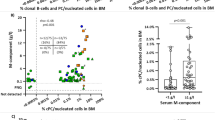Abstract
The determination of monoclonal protein (M-protein) by SPE, IFE and SFLC assay is fundamental in the diagnosis of Plasma cell proliferative disorder (PCPD). In the present study, we seek to assess the diagnostic performance and concordance of these three techniques in un-treated PCPD patients. All new patients with dysproteinemia and/or suspected PCPD were included in this retrospective observational study. The baseline parameters were retrieved from electronic medical records. SPE was performed on gel electrophoresis system; monoclonal component was identified by IFE. SFLC assays were performed by nephelometry using a latex-enhanced immunoassay. Total 402 patients of PCPD were included (10.9% of MGUS/SMM and 89.1% of multiple myeloma). The combination of SPE + rSFLC (ratio of kappa/lambda light chain) and SPE + IFE + rSFLC was able to detect M-protein across all subgroups of patients. In 61 patients, rSFLC values were within normal range (54.5% of MGUS/SMM and 10.3% of MM) and was more commonly seen with IgG lambda M-protein (57.4% vs. all-others). The median dFLC value, among these patients, was higher for MM than MGUS/SMM patients (23.8 vs. 14.4 mg/L, respectively). The combination of SPE and rSFLC can be reliably used to detect M-protein in PCPD patients. In a small subgroup of MM patients, despite the presence of an intact immunoglobulin (M-protein), the rSFLC is not abnormal. Historically, these patients should respond better to treatment. However, a further follow-up analysis with more number of such patients would be advantageous for better understanding.

Similar content being viewed by others
Availability of data and material
The datasets generated during and/or analysed during the current study are available from the corresponding author on reasonable request.
References
Rajkumar SV. Updated diagnostic criteria and staging system for multiple myeloma. Am Soc Clin Oncol Educ Book. 2016;35:e418–23. https://doi.org/10.1200/EDBK_159009.
Katzmann JA. Screening panels for monoclonal gammopathies: time to change. Clin Biochem Rev. 2009;30:105–11 (PMID: 19841692).
Dispenzieri A, Kyle R, Merlini G, Miguel JS, Ludwig H, Hajek R, et al. International Myeloma Working Group guidelines for serum-free light chain analysis in multiple myeloma and related disorders. Leukemia. 2009;23:215–24. https://doi.org/10.1038/leu.2008.307.
Drayson MT, Tang LX, Drew R, Mead GP, CarrSmith HD, Bradwell AR. Serum free light-chain measurements for identifying and monitoring patients with nonsecretory multiple myeloma. Blood. 2001;97:2900–2. https://doi.org/10.1182/blood.v97.9.2900.
Corso A, Mangiacavalli S. Non-secretory myeloma: ready for a new definition? Mediterr J Hematol Infect Dis. 2017;9(1):e2017053. https://doi.org/10.4084/MJHID.2017.053.
Bradwell A. Serum free light chain analysis, 7th ed. Birmingham, UK: The Binding Site Ltd, 2015; pp. 24–25.
Jeong TD, Young Kim S, Jang S, Park C, Chi H, Lee W, et al. Diagnostic sensitivity of a panel of tests to detect monoclonal protein in Korean multiple myeloma patients. Clin Chem Lab Med. 2013;51(8):e187–9. https://doi.org/10.1515/cclm-2013-0116.
Dispenzieri A, Zhang L, Katzmann JA, Snyder M, Blood E, DeGoey R, et al. Appraisal of immunoglobulin free light chain as a marker of response. Blood. 2008;111:4908–15. https://doi.org/10.1182/blood-2008-02-138602.
Snozek CLH, Katzmann JA, Kyle RA, Dispenzieri A, Larson DR, Therneau TM, et al. Prognostic value of serum free light ratio in newly diagnosed myeloma: proposed incorporation into the international staging system. Leukemia. 2008;22:1933–7.
Levinson SS. Hook effect with lambda free light chain in serum free light chain assay. Clin Chim Acta. 2010;411:1834–6. https://doi.org/10.1016/j.cca.2010.07.027.
Li C, Geng H, Yang Z, Zhong R. Influence of immunoglobulin light chain dimers on the results of the quantitative nephelometric assay. Clin Lab. 2011;57:53–7 (PMID: 21391465).
Levinson SS. Polyclonal free light chain of Ig may interfere with interpretation of monoclonal free light chain κ/λ ratio. Ann Clin Lab Sci. 2010;40:348–53 (PMID: 20947809).
Tacchetti P, Rocchi S, Pezzi A, Zamagni E, Pantani L, Zannetti B, et al. Prognostic impact of serum free light chain assay in newly diagnosed multiple myeloma treated with bortezomib. Blood. 2013;122:1859a. https://doi.org/10.3109/10428194.2015.1124994.
Rajkumar SV, Kyle RA, Therneau TM, Melton LJ, Bradwell AR, Clark RJ, et al. Serum free light chain ratio is an independent risk factor for progression in monoclonal gammopathy of undetermined significance. Blood. 2005;106:812–7. https://doi.org/10.1182/blood-2005-03-1038.
Durie BGM, Harousseau JL, Miguel JS, Blade J, Barlogie B, Anderson K, et al. International uniform response criteria for multiple myeloma. Leukemia. 2006;20:1467–73. https://doi.org/10.1038/sj.leu.2404284.
Landgren O, Kyle RA, Pfeiffer RM, Katzmann JA, Caporaso NE, Hayes RB, et al. Monoclonal gammopathy of undetermined significance (MGUS) consistently precedes multiple myeloma: a prospective study. Blood. 2009;113:5412–7. https://doi.org/10.1182/blood-2008-12-194241.
Rajkumar SV, Kyle RA, Buadi FK. Advances in the diagnosis, classification, risk stratification, and management of monoclonal gammopathy of undetermined significance: implications for recategorizing disease entities in the presence of evolving scientific evidence. Mayo Clin Proc. 2010;85:945–8. https://doi.org/10.4065/mcp.2010.0520.
Kyle RA, Gertz MA, Witzig TE, Lust JA, Lacy MQ, Dispenzieri A, et al. Review of 1027 patients with newly diagnosed multiple myeloma. Mayo Clin Proc. 2003;78(1):21–33. https://doi.org/10.4065/78.1.21.
Becker N. Epidemiology of multiple myeloma. Recent Results Cancer Res. 2011;183:25–35. https://doi.org/10.1007/978-3-540-85772-3_2.
Lalit Kumar, COMY 2016, Multiple myeloma-Indian perspectives: current situation, viewed 04th April 2020, http://comy2016.cme-congresses.com/Sites/319/Editor/Documents/Kumar%20abstract.pdf
Jacob LA, Suresh Babu MC, Lakshmaiah KC, Babu KG, Lokanatha D, Rajeev LK, et al. Multiple myeloma: experience of an institute in limited resource setting. Indian J Cancer. 2017;54:340–2. https://doi.org/10.4103/ijc.IJC_87_17.
Acknowledgements
Mr. Ashok Kumar, Mr. Manoj Singh, Mr. Kaushal, Mr. Rahul, Mr. Manoj Sarkar and Mr. Ramdev from the Myeloma Lab, Department of Hematology, SGPGIMS, Lucknow, for performing the SPE, IFE and SFLC assays.
Author information
Authors and Affiliations
Contributions
MKS, VP and SD: data retreivement, MKS, DC, RG, KR: manuscript writing, AG, SK, RK, SN: patient recruitment and management.
Corresponding author
Ethics declarations
Ethical Approval
The study was approved by institutional ethics committee.
Consent to Participate
An informed consent was taken.
Consent to Publication
An informed consent was taken.
Additional information
Publisher's Note
Springer Nature remains neutral with regard to jurisdictional claims in published maps and institutional affiliations.
Rights and permissions
About this article
Cite this article
Singh, M.K., Paswan, V., Dwivedi, S. et al. An Analysis of M-protein in Plasma cell Dyscrasia Patients Identifies that IgG Lambda Subtype is More Commonly Associated with Normal Serum Free Light Chain (SFLC) Ratio. Ind J Clin Biochem 37, 466–472 (2022). https://doi.org/10.1007/s12291-021-01017-5
Received:
Accepted:
Published:
Issue Date:
DOI: https://doi.org/10.1007/s12291-021-01017-5




